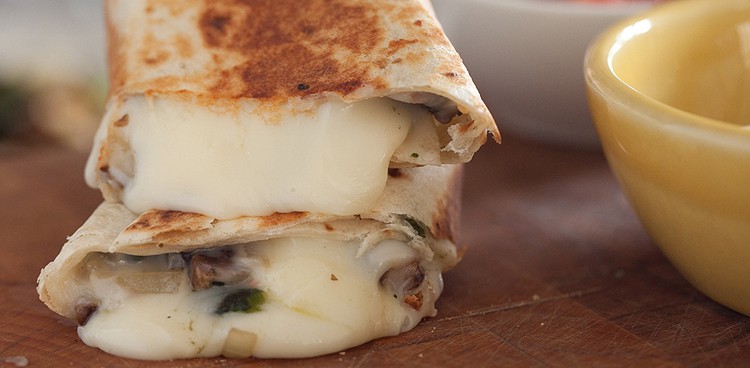
Mexican cheeses are some of the most popular Latin American cheeses in the US – and there’s no doubt why. With our close proximity to our neighbor to the south, we have a happy familiarity with cheesy Mexican-derived dishes such as quesadillas and fajitas. Mexico is ranked as the 10th largest producer of cheese in the world, so it shouldn’t come as any surprise that the realm of Mexican cheeses includes more than just plastic pouches of “four cheese blend” orange and yellow shreds you find at the supermarket.
Though there are countless varieties of Mexican cheese, today we’re going to focus on three different types. From the aged Cotija, to the freshly made Oaxaca, and the rare Bola de Ocosingo, each cheese has its own traditions and story behind it.
Cotija de Origen

Photo Credit: Image courtesy of Lactography
Cotija de la Paz is a city within the state of Michoacan and the home of Cotija, a raw milk cheese and aged for 2–5 months. For this salty and crumbly cheese, it’s all about the milk and the cows. Farmers use a process of transhumance, bringing their cattle up into the mountains and moving them from one grazing field to another. The different altitudes and weather conditions can actually affect the flavor. Typically the cheese is only produced during the rainy season, which lasts from July to October.
It is thought that the process of making Cotija was most likely brought over by Italian immigrants, looking for a local substitute for Parmigiano Reggiano, as Cotija is very similar to Parmesan in its firmness and saltiness. It also goes very well grated or crumbled over anything, like these Fully Loaded Nachos.
In order to be considered real Cotija (as you can find many variations in the United States), the cheese needs to have been produced in the city of Cotija de la Paz. However, because it is a raw milk cheese, it is very difficult to get authentic Cotija across the border. Carlos Yescas of Lactography is currently trying to develop a trademark for Cotija de Origen and hopes to soon be able to export to the US.
Queso de Oaxaca

Photo Credit: Image courtesy of Cheese Chick Chat
Queso Oaxaca is a very strange looking but tasty cheese. It is a fresh cheese made in the pasta filata style, stretching the cheese into long ribbons and rolling it up like a ball of yarn. It is very similar in texture to other pasta filata cheeses, like string cheese and mozzarella, which contributes to its popularity. In fact, it is rumored that it was an Italian immigrant longing for mozzarella who began making Queso Oaxaca. From there, it really took off.
You can find it all over Mexico, as well as pasteurized versions in the US. The flavor is tangy and almost sour, but with an aroma of fresh milk. It became very popular for its capacity to melt, but not brown, making it the perfect cheese for a quesadilla.
Bola de Ocosingo
Unlike Cotija and Oaxaca, you will be hard-pressed to find versions of this cheese in the US. In fact, you might even have trouble finding it in Mexico. Produced by small family co-ops surrounding the city of Ocosingo in the state of Chiapas, this cheese is another raw cow’s milk cheese. Some believe that the recipe for Bola de Ocosingo was developed while following a recipe for the spherical Dutch cheese Edam; however, others believe the cheese is more similar to the Italian Caciocavallo in type and form.
During its less than 60-day aging period, the outer rind hardens and forms a casing that is sometimes yellow. The paste inside is a bright yellow and the texture is like cream cheese. The flavor is sharp and milky, with a subtle herbal aroma. It is also very salty, making it good accompaniment for other foods.
According to Yescas, the cheese is a source of pride for the small rural community. “The village of Ocosingo really just has a plaza and a church and nothing else. These people all work together, and they are super proud that their cheese is famous now in Mexico.”
There has not yet been a single recipe established for this cheese, which makes it difficult to register for a trademark and difficult to sell outside of the state of Chiapas. It’s for this reason that this cheese is so hard to get. However, Bola de Ocosingo is a true specialty and if you ever find yourself in a position to try some, it will be worth going the extra mile.
These cheeses are only a sampling of the wealth of cheeses Mexico has to offer, and with so much to choose from, there’s no reason to settle for the processed stuff. Next time you’ve got plans for nachos or quesadillas, pick up a true Mexican cheese like Cotija or Oaxaca.
Photo Credit: Featured image courtesy of The Meaning of Pie





I very much like and use Oaxaca cheese. One ingredient listed is “hannile”. What is this? Can
Not find it in any dictionary. Many thanks for your reply.
Not a ton widely available in my area, so I’ll say cotija?
If you click through that picture of the Queso Oaxaca is actually from one produced domestically in Oregon by Ochoa Queseria!
Favorite is hard- I often use Cotija as a less assertive sprinkle cheese in pasta.
I enjoy serving Haloumi like queso de freir fried on short bamboo spits as an appetizer.
Favorite Mexican cheese dish Chile relleno de queso.
Those all sound delicious!